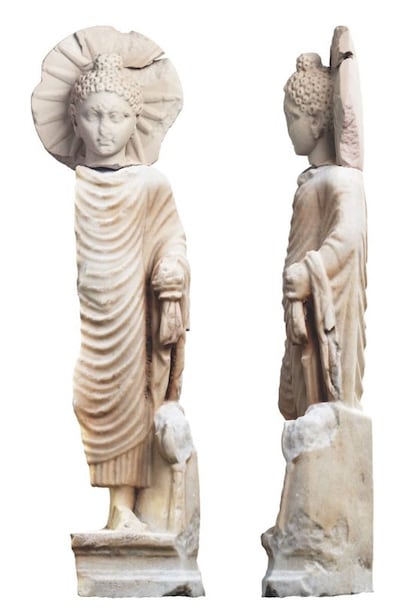Buddha in the land of the pharaohs: 2,000-year-old statue of Siddhartha Gautama discovered in Egypt
The figure was excavated in a temple to the goddess Isis at an ancient Red Sea port. It suggests that the two worlds were closer than previously thought

A Polish-U.S. archaeological mission has recently announced the discovery of an almost 2,000-year-old marble Buddha statue in a temple dedicated to the ancient Egyptian goddess Isis in Berenice, an important port city on the banks of the Reed Sea from the Greco-Roman period. It is the first complete figure of the father of Buddhism, Siddhartha Gautama, discovered in the country, and it sheds new light on the human and commercial links that existed between Roman Egypt and India.
The 71-centimeter statue shows Buddha standing next to a lotus flower, holding his clothing with the left hand and with a halo of sun rays around his head, in allusion to his radiant mind. The archaeologists who discovered it indicate that the figure is made of stone, probably extracted from a region in the south of present-day Istanbul, Turkey. They believe, though, that it was sculpted in Berenice and left in the temple by one or several rich Indian merchants that frequented the city. The team’s art historian, Marianne Bergmann, believes that it was made between the end of the first century and the first half of the second.
At that time, Europe was the center of a trade route that linked the Roman Empire with many regions of the ancient world, Indian among them. The most important port on the Red Sea was Berenice, where boats from India arrived with products like pepper, textiles and semi-precious stones. After unloading on the dock, the merchandise was loaded onto camels that transported it through the desert to the Nile, where other ships took the cargo to Alexandria and, from there, to the other side of the Mediterranean. “We know about the trade between India and Egypt in the Roman era, and there was material evidence of it,” says Rodney Ast, the researcher from Heidelberg University who discovered the Buddha figure. “These new discoveries suggest a level of cultural exchange that we hadn’t seen before,” he adds, saying the discovery “was very significant.”
In addition to the Buddha statue, Ast’s team also found in the temple to Isis an inscription in Sanskrit that dates back to the reign of the Roman emperor Philip the Arab (224-249 C.E), as well as two coins from the second century of the kingdom of the Satavahana dynasty in central India. They also discovered inscriptions in Greek, including one below the Sanskrit inscriptions, something Ast says is “unique in Egypt.”
The port city of Berenice was founded in the third century A.C.E. by the second pharaoh of the Ptolemaic dynasty of Ancient Egypt, Ptolemy II. The monarch ordered it to be constructed on the remote site on the Red Sea, in order to have access to the African elephants used in battle and other exotic animals and products, as explained by the Project Berenice team, directed by Ast along with historian Steven Sidebotham and Egyptologist Olaf Kaper. Remains of a fortress tower, a defensive wall and a port with an underground complex have also been discovered, which suggests that in the Ptolemaic era Berenice was a sprawling port. During Roman Egypt, however, it became an imperial port that received boats of merchandise from as far as India. Workshops flourished around it, as well as two structures believed to be temples.
In that period, according to the archaeologists who work there, Berenice was a vibrant city in the middle of the desert, where large fortunes and luxury items like bronze figures and precious crystals could be found. The trade links with India are well documented, but now the discovery of the Buddha statue, and the inscriptions in Sanskrit, suggest that links with Roman Egypt were tighter, and more personal, than previously thought. “It’s probable that the statues were carved in Berenice and, without a doubt, the inscription too. So the place had artisans capable of making those objects and people interested in ordering them,” explains Ast, who also points out that the discovery raises new questions. “What does it mean to make an offering of a Buddha statue in a Roman temple to Isis in Egypt? It is a topic that will keep anthropologists, historians and others busy for a while,” he says.
The discovery of the Buddha statue occurred in early 2022, but it was not announced until late this April by Egypt’s Supreme Council of Antiquities and the Polish Center of Mediterranean Archaeology in Cairo.
Sign up for our weekly newsletter to get more English-language news coverage from EL PAÍS USA Edition
Tu suscripción se está usando en otro dispositivo
¿Quieres añadir otro usuario a tu suscripción?
Si continúas leyendo en este dispositivo, no se podrá leer en el otro.
FlechaTu suscripción se está usando en otro dispositivo y solo puedes acceder a EL PAÍS desde un dispositivo a la vez.
Si quieres compartir tu cuenta, cambia tu suscripción a la modalidad Premium, así podrás añadir otro usuario. Cada uno accederá con su propia cuenta de email, lo que os permitirá personalizar vuestra experiencia en EL PAÍS.
¿Tienes una suscripción de empresa? Accede aquí para contratar más cuentas.
En el caso de no saber quién está usando tu cuenta, te recomendamos cambiar tu contraseña aquí.
Si decides continuar compartiendo tu cuenta, este mensaje se mostrará en tu dispositivo y en el de la otra persona que está usando tu cuenta de forma indefinida, afectando a tu experiencia de lectura. Puedes consultar aquí los términos y condiciones de la suscripción digital.
More information
Archived In
Últimas noticias
Most viewed
- Sinaloa Cartel war is taking its toll on Los Chapitos
- Oona Chaplin: ‘I told James Cameron that I was living in a treehouse and starting a permaculture project with a friend’
- Reinhard Genzel, Nobel laureate in physics: ‘One-minute videos will never give you the truth’
- Why the price of coffee has skyrocketed: from Brazilian plantations to specialty coffee houses
- Silver prices are going crazy: This is what’s fueling the rally











































